Limiting Reactant Practice Problem
TLDRThis educational video offers a clear introduction to the concept of limiting and excess reactants in chemistry. The presenter guides viewers through a step-by-step process to determine which reactant limits the production of magnesium oxide (MgO) when given quantities of magnesium (Mg) and oxygen (O2). By comparing the molar ratios required for the reaction, the video demonstrates that magnesium is the limiting reactant and calculates the maximum amount of MgO that can be produced, as well as the excess oxygen left over. The explanation is straightforward, making it an excellent resource for beginners looking to understand molar relationships in chemical reactions.
Takeaways
- 🔍 The video is a tutorial on determining the limiting reactant and excess reactant in a chemical reaction.
- 🧪 The chemical equation used in the problem is for the production of magnesium oxide (MgO) from magnesium (Mg) and oxygen (O2).
- 📝 The given amounts of reactants are 7.8 moles of Mg and 4.7 moles of O2.
- 🤔 The process of finding the limiting reactant involves calculating the amount of one reactant needed to use up all of the other reactant.
- 📉 To use all of the Mg, 3.9 moles of O2 are required, but since there are only 4.7 moles available, O2 is not the limiting reactant.
- 📈 Conversely, to use all of the O2, 9.4 moles of Mg are needed, which is more than the available 7.8 moles, indicating Mg is the limiting reactant.
- 🏁 The limiting reactant dictates the maximum amount of product that can be formed; in this case, Mg limits the production of MgO.
- ⚖️ The greatest amount of MgO that can be produced is calculated using the moles of the limiting reactant, Mg, which results in 7.8 moles of MgO.
- 🧩 The excess reactant is determined by subtracting the amount of reactant used from the total amount available, leaving 0.8 moles of O2 unused.
- 📚 The video suggests that once comfortable with this basic concept, viewers should explore more complex problems involving unit conversions between grams and moles.
Q & A
What is the main topic of the video?
-The main topic of the video is determining the limiting reactant and excess reactant in a chemical reaction, specifically using the example of producing magnesium oxide (MgO) from magnesium (Mg) and oxygen (O2).
What chemical equation is used in the problem presented in the video?
-The chemical equation used in the problem is 2Mg + O2 → 2MgO, which shows the reaction of magnesium with oxygen to form magnesium oxide.
What are the initial amounts of reactants given in the problem?
-The initial amounts of reactants given are 7.8 moles of magnesium (Mg) and 4.7 moles of oxygen (O2).
How does the video determine which reactant is the limiting reactant?
-The video determines the limiting reactant by calculating how much of each reactant is needed to use up the other completely and seeing which one would run out first.
What is the stoichiometric ratio of magnesium to oxygen in the reaction?
-The stoichiometric ratio of magnesium to oxygen in the reaction is 2:1, meaning two moles of magnesium react with one mole of oxygen.
How many moles of oxygen are needed to react with all the given magnesium?
-To react with all 7.8 moles of magnesium, 3.9 moles of oxygen are needed.
How many moles of magnesium are needed to react with all the given oxygen?
-To react with all 4.7 moles of oxygen, 9.4 moles of magnesium are needed.
Which reactant is identified as the limiting reactant in the video?
-Magnesium is identified as the limiting reactant because there is not enough magnesium to react with all the oxygen.
What is the maximum amount of magnesium oxide that can be produced with the given amounts of reactants?
-The maximum amount of magnesium oxide that can be produced is 7.8 moles, which is based on the amount of the limiting reactant, magnesium.
How much excess oxygen is left after the reaction, according to the video?
-After the reaction, there are 0.8 moles of oxygen left over, which is the excess reactant.
What is the final step in solving a limiting reactant problem according to the video?
-The final step in solving a limiting reactant problem is to calculate the excess reactant by subtracting the amount of reactant used from the total amount available.
Outlines
🔍 Identifying the Limiting Reactant in a Chemical Reaction
This paragraph introduces the concept of limiting and excess reactants in a chemical reaction, specifically focusing on the production of magnesium oxide (MgO) from magnesium (Mg) and oxygen (O2). The problem presented involves determining the limiting reactant between Mg and O2, given 7.8 moles of Mg and 4.7 moles of O2. The process involves calculating the amount of each reactant needed to consume the other completely and identifying which reactant will be exhausted first, thus limiting the reaction. The key equation relating the moles of Mg to O2 is highlighted, with a step-by-step guide on how to use stoichiometry to find out which reactant is in excess and which will limit the reaction.
🧪 Calculating the Limiting Reactant and Excess Reactant
The second paragraph delves into the calculations needed to determine the limiting reactant between magnesium and oxygen. By using stoichiometry, it is established that 3.9 moles of oxygen would be required to react with 7.8 moles of magnesium, and conversely, 9.4 moles of magnesium would be needed to react with 4.7 moles of oxygen. Since there is not enough magnesium to react with all the available oxygen (only 7.8 moles of Mg compared to the 9.4 moles required), magnesium is identified as the limiting reactant. The paragraph then explains how to calculate the maximum amount of magnesium oxide that can be produced using the limiting reactant, which in this case is 7.8 moles of Mg, leading to 7.8 moles of MgO. Finally, the calculation for the excess reactant (oxygen) is shown, revealing that 0.8 moles of O2 will be left over after the reaction.
📚 Summary of Limiting and Excess Reactants Problem
The final paragraph wraps up the problem by summarizing the steps taken to solve a limiting and excess reactants scenario. It reiterates the process of identifying the limiting reactant, calculating the maximum amount of product that can be formed using this reactant, and determining the amount of excess reactant left over. The paragraph also encourages viewers to explore more complex problems involving limiting reactants and to practice converting between grams and moles, suggesting additional resources for those looking to deepen their understanding of chemical reactions.
Mindmap
Keywords
💡Limiting Reactant
💡Excess Reactant
💡Moles
💡Conversion Factor
💡Chemical Equation
💡Stoichiometry
💡Balanced Equation
💡Chemical Reaction
💡MgO (Magnesium Oxide)
💡Practice Problem
Highlights
The video focuses on a practice problem involving limiting and excess reactants.
It is an introductory problem suitable for beginners learning about limiting reactants.
The problem involves calculating the greatest amount of MgO (magnesium oxide) that can be produced.
The reactants given are 7.8 moles of Mg (magnesium) and 4.7 moles of O2 (oxygen).
The equation used to answer the problem is related to the stoichiometry of the reaction.
The concept of moles is central to solving the problem.
The limiting reactant is determined by comparing the required moles of each reactant to the moles available.
A conversion factor is used to find out how many moles of oxygen are needed to use all the magnesium.
It is calculated that 3.9 moles of oxygen are needed to react with 7.8 moles of magnesium.
A similar calculation is done to find out how many moles of magnesium are needed to use all the oxygen.
It is determined that 9.4 moles of magnesium are needed to react with 4.7 moles of oxygen.
Magnesium is identified as the limiting reactant because there is not enough to react with all the oxygen.
The greatest amount of MgO that can be made is calculated using the moles of the limiting reactant, magnesium.
The calculation shows that 7.8 moles of MgO can be produced.
The excess reactant is determined by subtracting the used oxygen from the total available oxygen.
It is found that 0.8 moles of O2 are left over as the excess reactant.
The video concludes with a summary of the steps to solve limiting and excess reactant problems.
The presenter suggests watching more advanced videos on limiting reactants for further practice.
Transcripts
Browse More Related Video

Stoichiometry - Limiting & Excess Reactant, Theoretical & Percent Yield - Chemistry

Lesson 8 - Atomic Theory Of Matter, Part 3 (Chemistry Tutor)

Synthesis Reactions

Limiting Reactant Practice Problem (Advanced)

ALEKS: Identifying the limiting reactant in a drawing of a mixture

Theoretical, Actual, Percent Yield & Error - Limiting Reagent and Excess Reactant That Remains
5.0 / 5 (0 votes)
Thanks for rating: